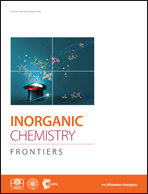HBPEI-grafted carbon nanotubes for the effective retention of Pd2+ and Pt2+ through complexation†
Abstract
Hyperbranched poly(ethyleneimine) (HBPEI) molecules in solution present high capacity to form stable complexes with transition metal ions due to the large number of amino groups ready to form chelates. We grafted HBPEI molecules to a multi-walled carbon nanotube (MWCNT) surface through covalent bonding, preparing solid hybrids which retain the chemical properties of the free poly-alkylamine molecules. In this way, we are able to transfer the complexation capacity of such molecules to a solid material adequate to act as a high-capacity sorbent for metal transition ions. We tested the HBPEI/MWCNT hybrids for the retention of Pd2+ and Pt2+ and the retention values obtained are much larger than those previously reported with fast retention kinetics. The kinetics and the XPS analysis of the metal ion/HBPEI/MWCNT ensemble indicate that the retention takes place through the formation of chelates with two or three nitrogen atoms and with Cl− anions as co-ligands. Moreover, the results allow us to tune the metal loading on the hybrids by controlling the solution conditions. This is important because the XPS valence band analysis demonstrates that metal complexation directly modifies the electronic behaviour of the carbon nanotubes, which supports the stable covalent bond between HBPEI molecules and MWCNT and opens the possibility for tuning the electronic properties of the tubes.



 Please wait while we load your content...
Please wait while we load your content...